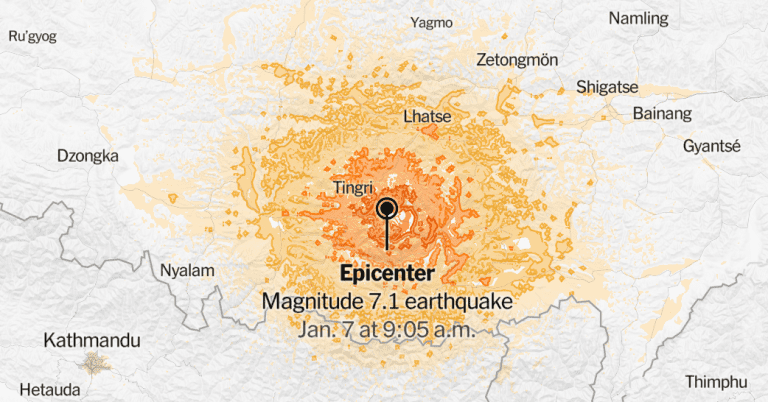Dozens of people were killed and hundreds of buildings collapsed after a 7.1-magnitude earthquake struck an area near one of Tibet’s holiest cities near the Himalayan border with Nepal on Tuesday. The tremors were felt in Nepal.
The quake struck shortly after 9 a.m. at a depth of 6.2 miles in Dingri County in Tibet, Chinese state media reported. They reported that at least 95 people died and 130 were injured. Xinhua, the official news agency, released videos of police clearing debris and picking up debris.
China’s state television reported that more than 1,000 houses collapsed in Dingri County, which lies at the northern foot of Mount Everest.
Several aftershocks were felt in the region, including in Nepal. The earthquake measured 7.1 on the Richter scale, according to the United States Geological Survey, although it was measured as 6.8 by the China Network Earthquake Center.
The nearest city to the epicenter was Shigatse, the second largest city in Tibet, with a population of 640,000. Shigatse is considered a holy place as the seat of Panchen Lama, one of the highest figures of Tibetan Buddhism.
A tourist near Shigatse who spoke to The Times said she was in her hotel room when the quake began to shake her building. She said the power went out and she and a friend were squatting between the beds. When the shaking stopped, they ran out of the building.
The tourist, who gave only her last name, Xu, shared a video showing several single-story brick buildings with collapsed walls. Video posted on Chinese social media shows streets littered with rubble, cars crushed by falling bricks and roads opened by the shifting ground. Ms. Xu said she grabbed her jacket before running outside.
China’s Supreme Leader Xi Jinping ordered officials to minimize casualties and resettle survivors. Chinese authorities deployed 1,500 rescuers and more than 250 vehicles to the search effort, which was conducted in frigid conditions, with temperatures dropping as low as 5 degrees Fahrenheit (minus 15 degrees Celsius). In photos released by state media, rescuers can be seen digging through piles of rubble from collapsed houses using ropes, shovels and working by hand.
The Himalayan region is prone to strong earthquakes. In 2015, a magnitude 7.8 earthquake in Nepal killed nearly 9,000 people. In Kathmandu, Nepal’s capital, residents rushed out of their homes this morning as the earthquake shook buildings.
At least two people, one in Kathmandu and another in Sindhupalchowk, an area north of Kathmandu, were slightly injured in the quake, Nepalese police said.
Nepal has sent more than 2,500 police officers to assess the damage and search for victims.
“Based on the magnitude of the earthquake, there could be some damage in the mountains of eastern Nepal,” said Lok Bijaya Adhikari, a senior seismologist at the Nepal National Earthquake Monitoring and Research Center.
Most of the people from the high mountain areas of Nepal like Everest, Makalu, Rolwaling and Kanchenjunga have migrated to lowland areas to avoid the extreme cold of winter.
“Although most people migrate to the lower land during the winter season, some are still there,” said Ang Tshering Sherpa, the former head of the Nepal Mountaineering Association. “There is always a risk of avalanche flooding and glacial lake outbursts after earthquakes.”
Berry Wang contributed to the report.




